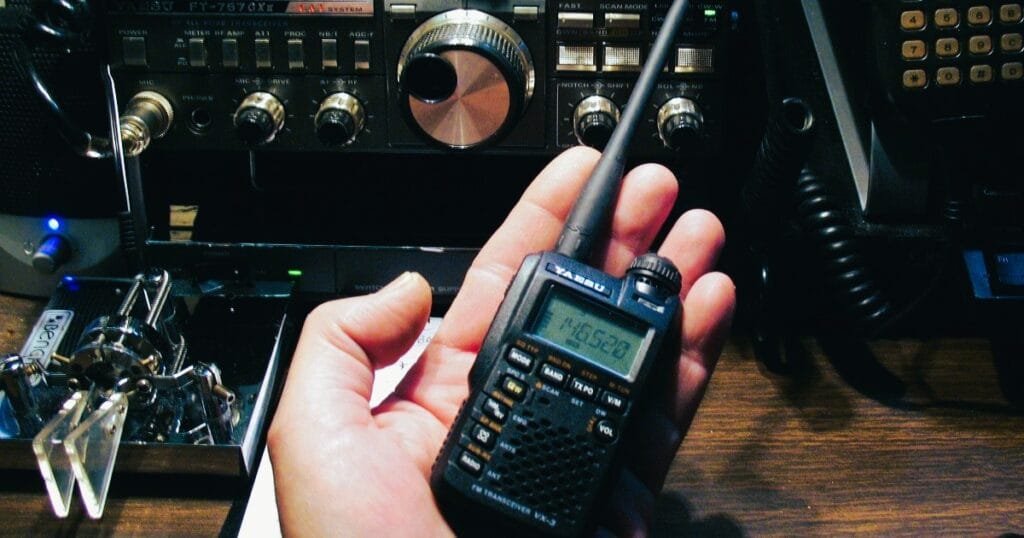Table of Contents
ToggleTypes of Frequencies Ham Radios Use: Guide to the Airwaves
Hello, fellow hams! How is the signal today? Hello and returning to TalkieTrail, your only source for amateur radio so far. No matter if you are new in ham radio hobby, or have utilized HAM for several epochs -being aware of the type’s frequency is essential to assure your communication process be clear and productive. In this article, we will discuss some of the kinds and classes that frequencies come in; of which could help you obtain better radio functionality.
What Exactly is Ham Radio Anyway?
New to ham radio? You might even just need a little reminder. One important thing: ham radio, amateur radio, or two way radio as it is also known —is not just a hobby. It’s a social network of sorts, where you can connect without Wi-Fi. Hams (amateur radio operators) use frequencies that the Federal Communications Commission assigns for human to people communications over any distance — across town, around the planet or even with astronauts in space.
If you are very new to the ham world, I recommend getting here cheering on exactly what is a walkie-talkie. To learn how walkie-talkies work, click here.
Whether you’re talking about the weather with a fellow ham, arranging your next major conversation, or assisting in the coordination of emergency responses during disasters, the frequencies you utilize are critical. Without them, you’re just a person speaking to yourself via a very expensive microphone.
The Spectrum of Frequencies: Ham Radio’s Playground

Now let’s speak about the types of frequencies because not all of them are created equal. Radio frequencies are similar to a large community, with each block (or band) having its own distinct ambiance. These bands are part of the radio frequency (RF) spectrum, which is separated globally to keep things nice and orderly. After all, no one enjoys disorganized airwaves!
So grab your favorite snack, because we’re going to dive into the frequency bands that hams utilize and why they’re important.
The Bands You’ll Love: Types of Frequency & Ranges

High-frequency (HF)
Frequency Range Type: 30-300 MHz.
Vibe Check: The HF bands are the radios equivalent of marathon runners. They reflect back off the ionosphere making it possible for you to talk with someone on the opposite side of our planet. Under the right conditions, and a bit of luck it could even make you an international ham radio star.
Common Uses: HF will be your best friend if you are a DXer (DX is shorthand for long-distance communication in hamSpeak). I find it handy in contests to see how many people you can work with very quickly. HF is the frequency where those QSOs are really worldwide.
Very High Frequency (VHF)
Frequency Range Type: 30-300 MHz.
Vibe Check: VHF transmissions are the local celebrities of the amateur radio world. They move by line of sight, so they’re ideal for communicating with folks in your vicinity. However, keep in mind that this frequency type might be difficult to use in mountainous or densely forested regions, so prepare accordingly.
Common Uses: VHF is primarily for local (line of sight)communications. Great for using repeaters (big-antenna helpers that increase range to WiFi on Deuce Down). What separated VHF from other bands was its dependability among emergency services in urban areas.
Ultra-High Frequency (UHF)
Frequency Range Type: 300 MHz to 3,000 MHz (3 GHz).
Vibe Check: UHF is like VHF’s cool cousin who lives in the city. UHF signals travel by line of sight, although they may pass through buildings and urban clutter more easily. However, these types of frequencies are more easily hindered by physical obstructions, so keep an eye out for towering buildings or mountains.
Common Uses: UHF is widely utilized in cities for repeater operations, satellite communication, and digital modes. So, if you’re in the concrete jungle and still want to reach the airwaves, UHF has got you covered.
Microwave Bands:
Frequency Range Type: Above 3 GHz.
Vibe Check: Microwave frequencies are more than just for warming pizza. These high-frequency bands are for hams who desire to test the limits of what is possible. These frequencies are utilized for satellite communication, experimental modes, and high-speed data transfer. Ham radio is for those who are genuinely daring!
Common uses: If you’re into amateur satellite operations, moonbounce (yes, it’s a thing), or digital modes that demand extremely high bandwidth, microwave bands are where the magic happens. Just be prepared to invest in some specialist equipment and perhaps brush up on your physics while you’re at it.
A question might arise: Which is the best of the two most commonly used bands, VHF or UHF? Check here to find out.
Band Plans and Regulations: Playing by the Rules
Now that we’ve covered the bands, let’s talk about their plans. Consider them roadmaps that keep everyone on the same page (or, in this case, wavelength). Band plans split each frequency band into smaller pieces for certain types of communication, such as speech, data, or the classic Morse code (CW). These plans help reduce confusion and interference, ensuring that everyone has a chance to be heard without stepping on each other’s signals.
But who maintains the peace over the airwaves? That would be the FCC and international regulatory agencies. They’re like radio referees, ensuring that everyone plays nice and follows the rules. So, before you hop onto a new frequency, double-check the band plan to ensure you’re in the right spot.
Types of Frequencies Tip: Band planning is your greatest friend when it comes to ensuring that you’re using the correct frequency for the mode you’re in. Whether you’re working with voice, data, or CW, double-checking the plan helps keep things running smoothly.
Popular Ham Bands: The All-Stars of the Airwaves

When it comes to amateur radio, certain bands are simply more popular than others. Here’s a brief ham radio review of a few favorites you should try:
80 meters (3.5-4.0 MHz): This band is ideal for nighttime communication across great distances. It’s similar to the comfortable night owl of the ham radio industry.
40 meters (7.0–7.3 MHz): 40 meters is a versatile and reliable option for local and worldwide communication, working well both day and night.
20 meters (14.0-14.35 MHz): This frequency, which is also referred to as the “DX band,” is mostly used for long-distance communication, especially in the daytime. If you want to go far and wide, 20 meters is your jam.
2 meters (144-148 MHz): The most popular VHF band for local communication, 2 meters is regarded as the social butterfly of amateur radio.
70 centimeters (420-450 MHz): This UHF band is ideal for local communications, repeaters, and digital modes.
Why Types of Frequencies Matter: The Heartbeat of RF
Okay, we’ve covered the fundamentals, but why should you worry about frequencies and their types? Simply put, understanding them is essential for good ham radio communication. Whether you’re chatting with a neighbor or reaching out to hams halfway around the world, selecting the appropriate frequency can make all the difference. Nobody enjoys dealing with a lost signal.
By understanding the features of each frequency type and adhering to the band plans and rules, you can avoid interference, make clear connections, and have a lot more fun on the airways. Plus, after you’ve mastered the frequencies, your next review will almost write itself!
Propagation: How Nature Affects Ham Radio Frequencies

Ever wondered why, one day your signal makes it to the other side of planet earth and on another day it struggles to reach across town? That is where the propagation takes over. Propagation: This is what we call the way radio waves move through our atmosphere and allow us to communicate between different locations. Solar activity, time of day and meteorological factors combine to shape the way specific frequencies respond.
The ionosphere’s high frequencies at night and the highly reflective nature of some layers can allow for bounces across continents. By contrast, the VHF and UHF frequencies are less affected by the ionosphere. Having some knowledge about propagation will enable you to make the correct decision on which frequency at what time ensuring your signal goes where it needs to go.
Frequency Types Tip: Watch Propagation Reports to Improve Your Ham Radio Activity Websites like QRZ.com. In addition to using those apps you might also want to keep an eye on this site http://www.swpc.
The Art of Tuning: Finding the Perfect Frequency
So, you just learned about the different frequency bands and how they work. Now let us discuss tuning. Getting your ham radio to function on the proper frequency is an artful blend of science, and a bit of gut feeling. You just need to locate the sweet spot where your signal is at both strong and clear, thus interference-free.
Today, the majority of ham radios on the market have digital displays with presets for common frequencies. Having said that, if you are working with older gear or like to be more hands on manual tuning can be an enjoyable process. And that is turning the dial to get a clear signal and then adjusting your settings accordingly.
Specialized Modes and Frequencies: Going Beyond Voice
The iceberg that is amateur radio, icebergs optional Some of the different specialized modes that people use with ham radio transmit on unique frequencies to communicate in a particular way. Below is a rough primer on typical modes:
CW (Morse Code) – The use of Morse code as one form the oldest radio communication, still used by many hams. It is very narrow bandwidth and hence it provides a better noise over voice compared to voice, which makes it good for long distance communication.
Digital Modes — Other modes common for text and data transmission over the airwaves include FT8, PSK31, and RTTY. Most of these modes are using HF frequencies and thus ideal for contacts in noise or low output power.
Satellite Communication — It provides satellite communication, if you ever wanted to bounce your signal off a satellite and speak to someone 1000s miles away working in google. Ham radio satellites, a.k.a. “Birds” provide that in spades and then some This provides a great variety of communication options as the satellite band operates in UHF and VHF bands.
Types of Frequencies for Emergencies
When all else fails, as is often the case in emergencies, amateur radio fills this gap. Disaster often knows no boundaries, and when conventional means of communication fail or break down altogether, hams apply their acumen in frequency selection and band allocations to keep the lines open. During a large-scale emergency crisis, they will typically use HF operation for long-distance communication (which would be urgent / priority —priority being medical or bring back services to key civil infrastructure when such is in trouble— at times) with VHF and UHF local coordination.
For the latter, getting the most use out of these frequencies and to be effective under pressure are key features. If you are passing messages or coordinating relief efforts, the amateur radio Frequencies can mean lives saved in an Emergency.
Final Thoughts: One Type of Frequency at a Time
The frequencies you use are the gateway to your entire experience in the world of amateur radio, so it’s a fantastic area to explore and learn. Whether you enjoy local VHF chats, long-distance HF DXing, or experimental operations in the microwave bands, there’s a place for you on the airwaves.
So keep turning those dials, stay curious, and remember—the airwaves are always there for you to explore. Stay tuned to TalkieTrail.com for more ham radio tips, techniques, and reviews.
Happy hamming, everyone!


